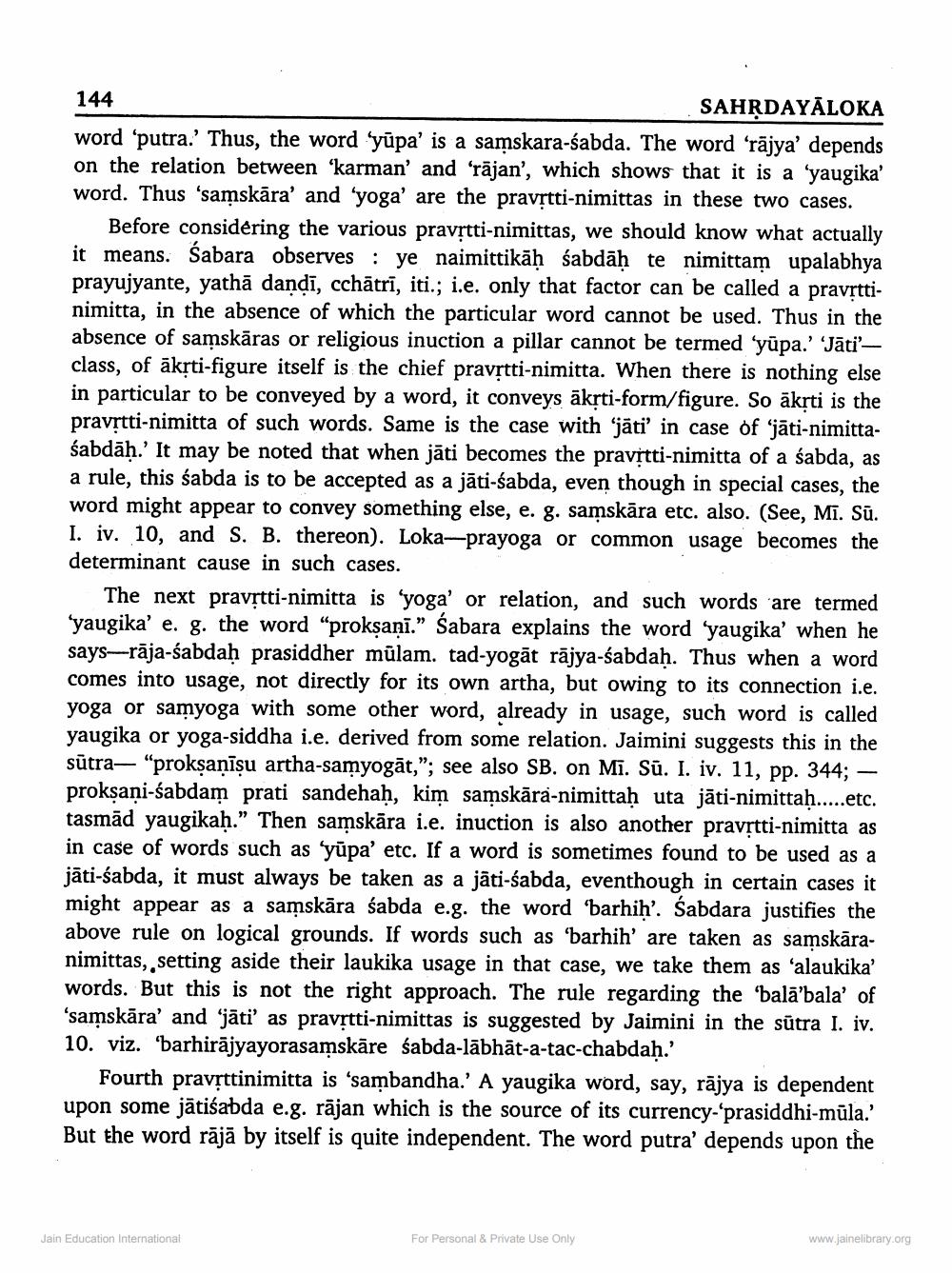________________
144
SAHRDAYĀLOKA word 'putra.' Thus, the word 'yūpa' is a samskara-sabda. The word 'rājya' depends on the relation between 'karman' and 'rājan', which shows that it is a yaugika' word. Thus 'samskāra' and 'yoga' are the pravrtti-nimittas in these two cases.
Before considering the various pravrtti-nimittas, we should know what actually it means. Śabara observes : ye naimittikāḥ śabdāḥ te nimittam upalabhya prayujyante, yathā dandī, cchātrī, iti.; i.e. only that factor can be called a pravrttinimitta, in the absence of which the particular word cannot be used. Thus in the absence of samskāras or religious inuction a pillar cannot be termed yūpa.' 'Jāti'class, of akrti-figure itself is the chief pravrtti-nimitta. When there is nothing else in particular to be conveyed by a word, it conveys ākşti-form/figure. So āksti is the pravrtti-nimitta of such words. Same is the case with “jāti' in case of 'jāti-nimittaśabdāḥ.' It may be noted that when jāti becomes the pravịtti-nimitta of a sabda, as a rule, this sabda is to be accepted as a jāti-sabda, even though in special cases, the word might appear to convey something else, e. g. samskära etc. also. (See, Mi. Sü I. iv. 10, and S. B. thereon). Loka-prayoga or common usage becomes the determinant cause in such cases.
The next pravrtti-nimitta is 'yoga' or relation, and such words are termed 'yaugika' e. g. the word "prokşaņi.” Sabara explains the word 'yaugika' when he says-rāja-sabdaḥ prasiddher mülam. tad-yogāt rājya-śabdaḥ. Thus when a word comes into usage, not directly for its own artha, but owing to its connection i.e. yoga or samyoga with some other word, already in usage, such word is called yaugika or yoga-siddha i.e. derived from some relation. Jaimini suggests this in the sūtra— “prokşanīsu artha-samyogāt,"; see also SB. on Mi. Sū. I. iv. 11, pp. 344; - proksani-sabdam prati sandehah, kim samskāra-nimittah uta jāti-nimittah.....etc. tasmād yaugikah.” Then samskāra i.e. inuction is also another pravstti-nimitta as in case of words such as yūpa' etc. If a word is sometimes found to be used as a jāti-sabda, it must always be taken as a jāti-sabda, eventhough in certain cases it might appear as a samskāra śabda e.g. the word 'barhih'. Sabdara justifies the above rule on logical grounds. If words such as 'barhih' are taken as samskāranimittas,, setting aside their laukika usage in that case, we take them as 'alaukika' words. But this is not the right approach. The rule regarding the 'balā'bala' of 'samskāra' and 'jāti' as pravrtti-nimittas is suggested by Jaimini in the sūtra I. iv. 10. viz. barhirājyayorasamskāre sabda-lābhāt-a-tac-chabdah.'
Fourth pravrttinimitta is 'sambandha.' A yaugika word, say, rājya is dependent upon some jātiśabda e.g. rājan which is the source of its currency-prasiddhi-mūla.' But the word rājā by itself is quite independent. The word putra' depends upon the
Jain Education International
www.jainelibrary.org
For Personal & Private Use Only




